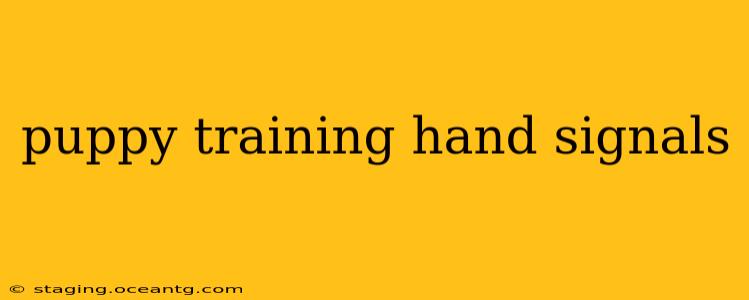Training your puppy is a rewarding experience, strengthening your bond and ensuring a well-behaved companion. While verbal commands are crucial, incorporating hand signals adds another layer of communication, especially in noisy environments or when your puppy is distracted. This comprehensive guide will explore effective hand signals for common commands, address frequently asked questions, and provide tips for successful training.
Why Use Hand Signals for Puppy Training?
Hand signals offer several advantages in puppy training:
- Clarity: Visual cues can be clearer than verbal commands, especially for puppies still learning to associate words with actions.
- Consistency: Hand signals provide a consistent cue, regardless of your tone or volume.
- Distraction-proof training: In noisy environments or when your puppy is highly stimulated, hand signals can cut through the distractions.
- Distance training: Hand signals allow you to communicate with your puppy from a distance.
- Enhanced communication: Combining hand signals with verbal commands strengthens the learning process.
Common Puppy Training Hand Signals and How to Teach Them
Here are some essential hand signals and how to effectively teach them to your puppy:
1. Sit:
- Hand signal: Hold your hand flat, palm up, and slowly move it upwards towards your puppy’s nose.
- Training method: As you give the hand signal, say "Sit" clearly and gently guide your puppy's rear end down with your other hand. Reward immediately with a treat and praise. Repeat frequently in short sessions.
2. Down:
- Hand signal: Hold your hand flat, palm down, and slowly move it downwards towards the ground in front of your puppy.
- Training method: Combine the hand signal with the verbal command "Down". Use a treat to lure your puppy into a down position. Reward immediately with a treat and praise. Gradually fade the lure.
3. Stay:
- Hand signal: Hold your hand up with your palm facing your puppy, fingers slightly spread.
- Training method: Start with short durations, rewarding your puppy for remaining in place. Gradually increase the duration as your puppy’s understanding grows. Introduce distractions gradually.
4. Come:
- Hand signal: Extend your arm and beckon your puppy with your hand.
- Training method: Pair this hand signal with the verbal command "Come". Initially, use a high-value treat to lure your puppy towards you. As they improve, gradually reduce your reliance on the treat. Always end the session with a "Come" and rewarding interaction.
5. Leave It:
- Hand signal: Hold your hand up, palm facing your puppy, as if blocking them from accessing something.
- Training method: Place a tempting treat on the ground. Give the hand signal and say "Leave it". If your puppy goes for the treat, gently block them. Once they look away, reward with a different treat and praise.
Frequently Asked Questions (FAQs)
What age is best to start using hand signals with puppies?
You can begin introducing hand signals as early as 8 weeks of age, alongside verbal commands. However, remember that puppies have short attention spans, so keep training sessions brief and positive.
How long does it take to teach a puppy hand signals?
The time it takes varies depending on the individual puppy's learning style and your consistency. Some puppies may learn quickly, while others may require more time and patience. Consistency and positive reinforcement are key.
Should I use hand signals alone or with verbal commands?
Ideally, combine hand signals with verbal commands, especially during the initial training stages. This creates a stronger association and helps your puppy learn more efficiently. Once your puppy understands, you can gradually phase out the verbal command.
What if my puppy doesn't understand the hand signals?
If your puppy isn't understanding, try breaking down the training into smaller steps, using higher-value rewards, and ensuring your hand signals are consistent and clear. Consider revisiting basic obedience commands to reinforce your puppy's understanding of the foundation. Consult a professional dog trainer if needed.
Are there any breeds that are harder to train with hand signals?
While some breeds may be naturally more inclined to learn quickly, every puppy is an individual. With patience, consistent training, and positive reinforcement, all breeds can learn hand signals.
Conclusion
Mastering puppy training hand signals enhances communication and strengthens the bond you share with your furry friend. Remember patience, positive reinforcement, and consistent training are key ingredients to success. With dedication and a clear approach, you and your puppy will enjoy effortless communication and a happy, well-behaved partnership for years to come.
